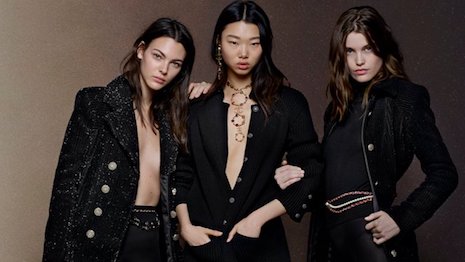- About
- Subscribe Now
- New York,
March 12, 2019

 Legacy luxury brands must be open to new trends. Image credit: Chanel
Legacy luxury brands must be open to new trends. Image credit: Chanel
From ecommerce expansion to personalization, the always-evolving luxury business seems to be going in countless new directions. One underlying theme, however, is balancing accessibility with privacy.
In its “Luxury Trends in 2019” report, CB Insights explored both “necessary” trends that have already seen wide adoption by luxury brands and “experimental” movements that researchers expect will rapidly gain traction. These trends impact all aspects of a luxury brand’s business, from products and distribution to marketing and technology.
“Like almost every other industry, luxury is getting disrupted by the emergence of new technologies,” said Thomas Sineau, senior intelligence analyst at CB Insights, New York. “Luxury companies will need to find innovative ways to preserve privacy while offering more and more connected services.
“Privacy has long been at the heart of the concept of luxury,” he said. “But as luxury clients are getting more connected, sharing experiences on social media and valuing services such as in-flight or in-car Wi-Fi, this notion of privacy is evolving.”
Next is now
Chinese affluents are among the top targets for luxury brands, and many marketers are turning to online platforms to reach these consumers.
Unlike ecommerce giant Amazon, Chinese counterparts Alibaba and JD.com have introduced specific luxury platforms to better reach luxury brands and consumers alike.
For instance, Alibaba launched Luxury Pavilion, its invite-only platform designed explicitly and exclusively for luxury brands, in 2017. Burberry, Hugo Boss, La Mer, Maserati, Guerlain and Zenith were among the first brands on the site (see story).
JD.com is leveraging services such as white glove delivery to attract more high-end brands. Image credit: JD.com
According to McKinsey, one of the unique ecommerce challenges in China is that up to three-quarters of wealthy Chinese live outside of the country’s major cities and shopping meccas.
JD.com is the only company licensed to distribute orders by drone and operates more than 100 drone bases throughout China, allowing it to better reach remote customers. The delivery experience is further elevated for luxury purchases (see story).
Looking more closely at apparel trends, it is clear that the casualization of luxury continues. Luxury labels including Balenciaga, Chanel and Louis Vuitton have embraced streetwear to varying degrees.
In particular, footwear and sneakers have become an entry point into luxury streetwear and casual wear.
Online retailer Farfetch is also forecasting the rise of high-end sportswear and sneakers with a new takeover of Stadium Goods as the sector overtakes traditional luxury footwear.
With its acquisition of marketplace Stadium Goods, Farfetch is proving its confidence in the premium sports footwear sector, but its decision was not based on a whim. The online retailer, which specializes in luxury goods, saw the rise in streetwear and premium sneakers from millennial and Gen Z groups and knew there was an overlap in the market (see story).
There remains more opportunity for growth in this segment.
For instance, higher-tier luxury brands can begin offering workout leggings and other items already sold by both high-end fitness brands such as Lululemon and premium brands, including Kate Spade.
Although streetwear has helped usher in a resurgence of logo-heavy styles, many consumers are also seeing appeal in unbranded luxury goods.
Brandless luxury pieces are produced with a high level of quality and craftsmanship, but are not associated with a particular brand’s heritage and can be sold at a more accessible price.
Cashmere scarves from a factory that has worked with Burberry, which retail for $95. Image credit: Italic
Los Angeles-based Italic, launched in 2018, aims to provide consumers with more value for their money while also giving producers who work with brands such as Frette and Gucci a greater share of profit. Leaning on the trend toward logoless luxury along with frugality, Italic seeks to disrupt the traditional supply chain (see story).
These goods also speak to consumers who are less interested in ostentatious pieces and possibly more interested in protecting their privacy.
As experiences continue to overtake products, luxury brands across sectors are also heightening their customer services. Concierge-style initiatives allow brands to better acquire information about their consumers without being intrusive or disregarding privacy.
In this respect, many luxury automakers such as Porsche include white-glove pickup and delivery services with their subscription services, heightening the experience beyond the usual sharing economy transaction.
Ticking trends
One particular industry still navigating its embrace of technology is the luxury watch and accessories segment.
Although luxury brands have attempted to enter smartwatch territory, their market share is still small. According to a NPD report, Apple, Samsung and Fitbit control 88 percent of all sales, but companies such as Fossil and Garmin are hoping to catch up.
Luxury watchmakers have attempted to penetrate the smartwatch market, but consumers are flocking to those that specialize in the sector (see story).
While some brands have introduced their own luxury smartwatches, others have chosen to collaborate with technology partners instead, including two French houses.
Hermès has teamed with Apple to release branded versions of the Apple Watch, including special straps and faces (see story). Originally launched in 2017, the Tambour Horizon is Louis Vuitton’s connected watch offering, which combines personalization, fashion and technology together in one design (see story).
“The luxury watch industry has had to adapt to disruption a bit earlier than other luxury brands due to Apple’s launch of its smartwatch in 2015,” CB Insights' Mr. Sineau said. “Luxury houses have, in general, been very careful not to rush into new technologies, taking their time to figure out what will add to their brand equity.”
Share your thoughts. Click here